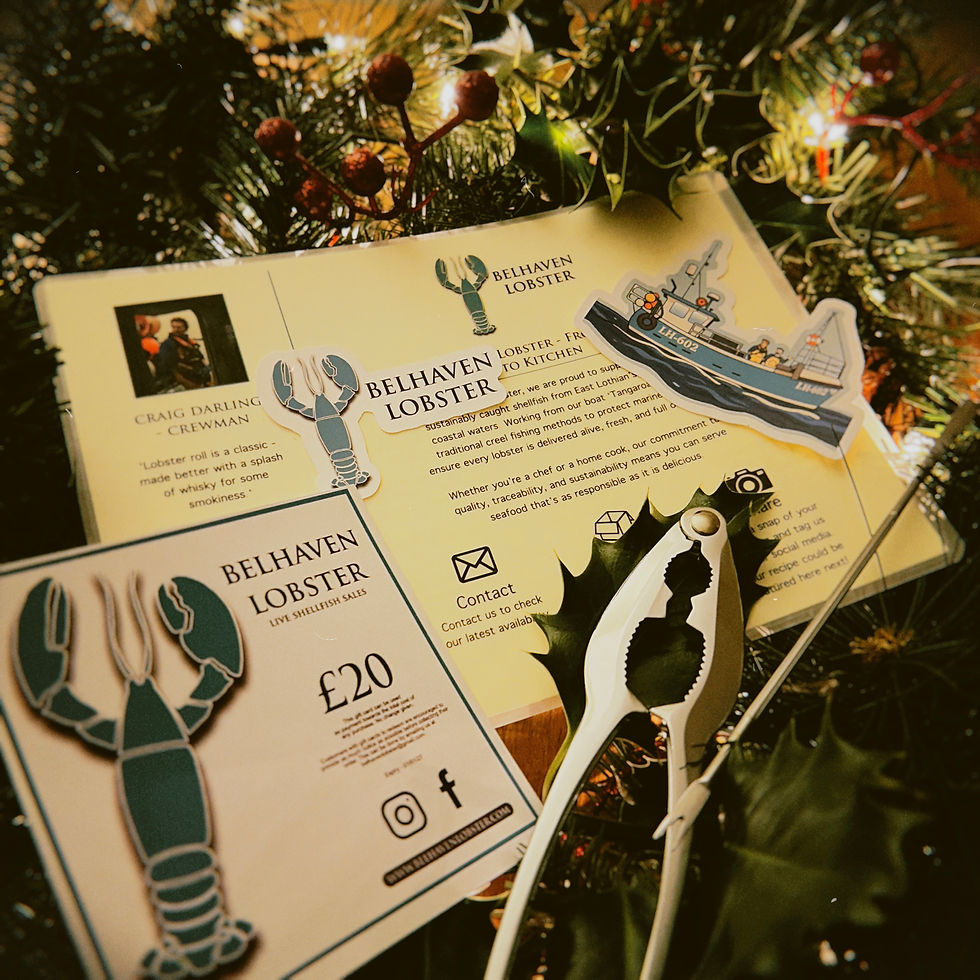🦞 Creel to Kitchen: The Journey of Your Lobster
- Lawrie McFarlane

- Sep 27
- 3 min read
🌊 Introduction
When you sit down to enjoy a perfectly cooked lobster — whether at home or in a fine-dining restaurant — it’s easy to forget the incredible journey that brought it to your plate.
Every lobster tells a story: from the waters where it was caught, to the skilled hands of fishermen and the care taken in transporting it alive and fresh. At Belhaven Lobster, we call this journey creel to kitchen — and it’s at the heart of everything we do.
In this post, we’ll walk you through the full process, showing you how your lobster gets from the sea to your kitchen with sustainability, quality, and care in every step.

⚓ Step 1: Shootting the creels
The journey begins when we head out before dawn, creels stacked high on the boat. Each creel is baited and dropped into the water at the fishing grounds and marked with colorful buoys that float on the surface in order to find the creels again.
Unlike large-scale industrial fishing, creel fishing is selective and sustainable:
Creels allow undersized lobsters and non-target species to escape.
Fishermen check their creels regularly, ensuring minimal impact on marine ecosystems.
This traditional method has been used for generations, protecting the sea floor while maintaining lobster populations.
🦞 Step 2: The Catch
When the creels are hauled back onto the boat, the excitement begins. Lobsters are carefully removed and immediately inspected. Not every lobster is kept — strict regulations ensure that only legal, healthy lobsters make the journey to your table.
Conservation rules include:
Size limits: Small lobsters are returned to the sea to grow. Oversized breeding lobsters are also protected.
V-notching: Egg-bearing females are marked and released to continue repopulating.
These rules are not just regulations — they’re part of a culture of respect for the sea that every fisherman upholds.

❄️ Step 3: Handling & Storage
Once banded, our lobsters are carefully stored in fish boxes with a continuous flow of sea water running through them whilst aboard the boat.
When the catch returns to shore, lobsters are transferred to oxygenated holding tanks which are set to optimal sea water temperatures. This step is crucial — it keeps lobsters fresh, lively, and stress-free until they’re ready for delivery.

🚚 Step 4: Transport & Delivery
The key to creel-to-kitchen quality is ensuring lobsters arrive alive and kicking to our customers.
Commercial clients (restaurants, hotels, caterers) receive bulk deliveries, tailored to their schedules.
Public customers can order smaller quantities for family dinners or special occasions which can then be collected from our store at Dunbar’s Victoria Harbour.
Every delivery is handled with care — guaranteeing lobsters reach you in peak condition.

👨🍳 Step 5: From creel to kitchen
Finally, the journey ends in your kitchen or on your restaurant’s pass. Whether you’re boiling lobster at home or plating butter-poached tails for fine dining, you can trust that your lobster has been:
Sustainably caught
Handled with care
Delivered fresh and alive
That’s the Belhaven promise.
🌱 Why creel to kitchen Matters
The creel to kitchen journey isn’t just about logistics — it’s about values.
Sustainability: By fishing responsibly, we protect lobster stocks for future generations.
Quality: Healthy, stress-free lobsters taste better and cook beautifully.
Trust: Our customers — from chefs to families — know exactly where their lobster comes from.
When you order from Belhaven Lobster, you’re not just buying seafood. You’re supporting local fishermen, responsible practices, and a tradition that connects communities to the sea.

📝 Conclusion: Taste the Story Behind Every Lobster
Every lobster has a journey — from the cold waters of the sea, to the creels set by skilled fishermen, and eventually to the table where it’s enjoyed.
At Belhaven Lobster, we’re proud to make that journey possible in a way that’s sustainable, responsible, and always focused on quality.
👉 Order your live lobsters today and taste the difference of true trap to table seafood.




Comments